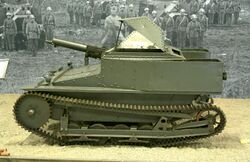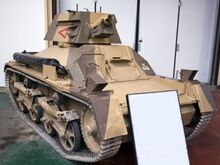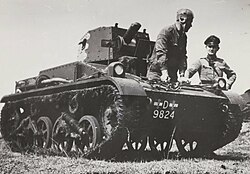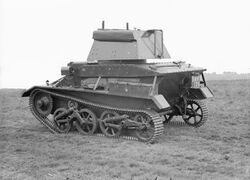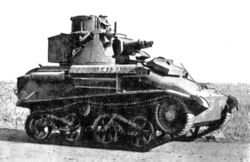Light tanks of the United Kingdom
Topic: Engineering
 From HandWiki - Reading time: 10 min
From HandWiki - Reading time: 10 min
| Tank, Light, Mk I to Mark V | |
|---|---|
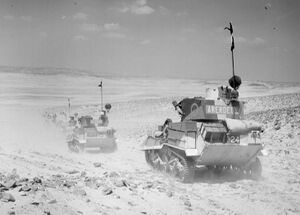 Vickers light tanks cross the desert, 1940 | |
| Type | Light tank |
| Place of origin | United Kingdom |
| Production history | |
| Designer | Vickers-Armstrongs |
| Manufacturer | Vickers-Armstrongs |
| Variants | Mk I, Mk II, Mk III, Mk IV, Mk V |
| Specifications (Light Tank, Mark V) | |
| Mass | 4.75 long tons (4.83 t) |
| Length | 12 ft 10 in (3.91 m) |
| Width | 6 ft 9 in (2.06 m) |
| Height | 7 ft 3 in (2.26 m) |
| Crew | 2 (Mk I-IV) 3 (Mk V) |
| Armour | 12 mm maximum |
Main armament | .50 in Vickers machine gun |
Secondary armament | .303 in Vickers machine gun |
| Engine | Meadows 6-cylinder petrol 88 hp |
| Suspension | Horstmann inclined springs |
Operational range | 130 mi (210 km) |
| Speed | 32.5 mph (52.3 km/h) |
The Light Tank Mark I to Mark V were a series of related designs of light tank produced by Vickers for the British Army during the interwar period.
Between the First and Second World Wars, the British produced a series of similar light tanks. They saw use in training, and in limited engagements with British Empire units such as the South African Army during the East African Campaign of 1941. All were around 5 long tons (5.1 t) in weight and capable of 30 mph (48 km/h) on roads and around 20 mph (32 km/h) cross-country.
The British did not expect their light tanks to be used against anything except other light tanks at most and as such armament was a machine gun only—Vickers machine guns firing either a .303 inch or .0.5 inch (12.7 mm) round. Suspension was Horstmann coil spring on bogies. The engine was a Meadows six-cylinder petrol. Up until the Mk V, they were crewed by a driver-commander and gunner. The Mk V had a driver, a gunner and a commander helping on the gun.
The various marks were produced in relatively small numbers. By the Mark V, the design was more or less optimised and it was the final development of in the form of the Light Tank Mk VI which was chosen for the British Army expansion programme in expectation of war.
The following designations in the sequence Light Tank Mk VII "Tetrarch" and Light Tank Mk VIII "Harry Hopkins" were produced by Vickers but unrelated to the series of light tanks Mk I to Mark VI.
Development
Tankettes
Following the activities of the Experimental Mechanized Force in the late 1920s, the British Army identified a need for two light tracked vehicles; one to carry a machine gun for the infantry and one with a turret for the Royal Tank Corps.[1] The Carden-Loyd tankette became the infantry vehicle, at the same time Carden privately developed a number of light, two-man tank designs. The Carden Mark VII design was accepted as a prototype for the army's light tank. By that point Carden-Loyd was part of Vickers-Armstrong. Only a few of the first light tanks were built and, although never issued per se, gave useful information for subsequent developments.
The Mark VII was a small machine gun-armed vehicle with a 59 hp (44 kW) Meadows engine which gave it a maximum speed of 35 mph (56 km/h). Suspension was two 2-wheel leaf sprung bogies on either side with an external girder to give the suspension strength. Considered a reconnaissance vehicle and a mobile machine gun position, the Mark VI was the final stage of development of the Carden-Loyd series of tankettes. The Carden-Loyd tankette was the prototype for the Universal Carrier.
Tank, Light, Mk I
The Mark I differed in a few points from Carden's Mark VII tankette. The external suspension girder was dropped by strengthening the suspension at the hull supports. The bevelled turret was replaced by a cylindrical design but still carried a single 0.303 Vickers machine gun. Giving it a 14 mm (0.55 in) "basis" of armour, increased weight and dropped the top speed to 30 mph (48 km/h).
The Meadows engine drove the tracks though a four-speed gearbox to the front drive wheels. Steering was a combination of de-clutching the drive to one track and braking to tighten the turn. The track was tensioned by a rear idler—which, being set at the same height as the drive sprocket, was new in British tank designs—and returned over three rollers.
The Mark IA had a larger superstructure and a larger turret to give room for operating the machine gun. Horstmann suspension with horizontal coil springs replaced the leaf springs of the Mark I. Although it could give an easy ride under moderate conditions, the springs could, under certain circumstances, cause an uncontrollable bounce. The engine was also changed to a Ricardo diesel engine.[2]
The Mark IA tanks sent to India in 1931 for trials received modifications to improve engine cooling in the hotter climate and various means were experimented with to reduce the heat for the crew as well.
- Mk I: four or five made, based on the Carden-Loyd Mk VIII
- Mk IA: nine produced, four of these were sent for trials in India[2]
Tank, Light, Mk II
The Mark II used a 66 hp (49 kW) Rolls-Royce engine which was, along with the Wilson preselector gearbox and transmission, on the right-hand side of the tank. This left the left-hand side free for the driver and commander. Tanks for use in India had an 85 hp (63 kW) Meadows engine and a "crash" gearbox. The turret was rectangular in form and the machine-gun was modified for vehicle use with a pistol grip instead of the spade grips of the infantry version.[3]
- MK II: 16 built by Vickers Armstrong from 1929
- Mk IIA: 29 constructed at the Royal Arsenal, Woolwich
- Mk IIB: 21 built by Vickers-Armstrong[3]
The running gear of the Vickers Light Dragon Mark I artillery tractor used the tracks and suspension of the Light Tank Mk II, and that of the Light Dragon Mark IIA used the components from the Light Tank Mk IIA.
Tank, Light, Mk III
The Mark III light tank suspension was made out of Horstmann coil springs controlling bogies with two rubber-lined wheel sets per bogie. This design, invented by Sidney Horstmann and exclusively used on lightweight vehicles, was also used up to the Light Tank Mk VI. Apart from being relatively easy to build, compact and lightweight, it had the advantage of having a long travel and was easy to replace when damaged in the field.[4] The drive sprocket was in the front while the idler-wheels were placed in the rear, with two return rollers. Power came in the form of a Henry Meadows six-cylinder petrol engine, producing 88 hp (66 kW), coupled with a four-speed preselector gearbox. Steering was a combination of de-clutching the drive to one track and braking to increase the turn. The traverse of the turret was electrically actuated.[5]
- Forty-two produced from 1934. Rolls-Royce engine and Wilson gearbox. Extended rear superstructure. Revised suspension. Thirty-six sent to Egypt.[3]
- The Royal Netherlands East Indies Army ordered 73 Mk IIIBs in 1937 and they were used during the Dutch East Indies campaign against Japan[6]
- Modified for Belgium as the Vickers T-15 light tank
- A single Vickers Light Dragon Mark IIB artillery tractor (which used the chassis and running gear from the Light Tank Mk III) was purchased by Belgium. It was considerably modified to produce the much heavier T-13 B3 tank destroyer armed with a 47 mm Model 1931 anti-tank gun.[7] These vehicles were made in Belgium under licence in Familleureux, Hainaut, by the Ateliers de construction de et à Familleureux (fr).[8]
Tank, Light, Mk IV
The Mark IV saw use in training, and weighed about five tonnes. These models had crews of two and were armed with Vickers machine guns. The idler wheels were removed, with the bogie wheels being respaced.[9] The design once again used a Meadows built engine this time rated for 90 HP.[10]
29 of the Mk IV A version are sent to India.[11] These had their turret extended upwards.[11] The British 9th Armoured Car and Light Tank Company, Royal Tank Corps, were equipped with Vickers-Carden-Loyd Mk.IV Light Tanks. They were sent to the North-West Frontier of India and took part in the 1936-1939 Waziristan campaign against the fiercely independent Pashtun tribesmen that inhabited that mountainous region. They were led by the religious leader Mirzali Khan and deployed guerrilla tactics of ambush and were not drawn into a decisive battle with the well trained and numerically superior British troops. The use of bullet-proof machine-gun armed tanks and air attacks by six RAF squadrons to support the infantry saw the support for Mirzali Khan begin to wane. In 1940 the North-West Frontier quietened down with only the occasional raid on a village by the tribesmen. It remained this way until 1947 and the end of British rule, and the founding of the independent state of Pakistan. Although some were still in use at the start of World War Two, they were removed as not fit for service in armoured divisions.
- A Vickers design of 1933, 34 built from 1934.
A surviving MkIV is the oldest running tank in the collection of The Tank Museum,Bovington.[12]
Tank, Light, Mk V
The biggest change from the Mark IV to the Mark V was the introduction of a three-man crew.[13] The turret now carried the commander and the gunner, who was also the radio operator. The increase in the crew size increased the tank's effectiveness and spread the maintenance load. Until then, the commander had to direct the driver, navigate and operate the gun. If troop commander, he also directed the other tanks and their fire.
The armament of the Mark V was an improvement over the earlier marks; a 0.5 inch Vickers machine gun was added to the existing 0.303.[9] The bigger gun gave the tank a reasonable capability against other light tanks—at the time most European light tanks had around 12–14 millimetres (0.47–0.55 in) of armour—but it was not updated as light tanks with more armour came into use. It was half a ton heavier—and about 18 inches longer—than the Mark IV. The weight increase had the effect of reducing the top speed to 32 mph (51 km/h) though range was largely unchanged. The first tanks produced were sent along with a team from Vickers to the 1st Battalion RTC. This unusual level of co-operation between manufacturer and user led to rapid resolution of problems and implementation of improvements. During 1936, 22 were produced.[3]
Light Tank Mk VI
The Light Tank Mk VI was a continuation of the Mark V design. It also had a three-man crew but a larger turret to accommodate a radio set and had an 88 hp engine for higher speed, despite the heavier weight. Between 1936 and 1940, over 1,300 Mark VIs were built, in several variants that represented solutions to problems with the initial design.[3]
Commercial Carden-Loyd tanks
The basic form of the light tank was used by Vickers for export markets. This included the 1933, 1934, 1936 and 1937 models. Buyers included Finland, Lithuania, Latvia, Argentina, Belgium, Switzerland, the Dutch East Indies and China.
Forty-two were produced for Belgium in 1935, based on the Mark III with a different turret on request of Belgium's armed forces. Armed with a French 13.2 mm Hotchkiss machine gun, they were designated Char Léger de Reconnaissance Vickers-Carden-Loyd Mod.1934 T.15 by the Belgians.
After two tanks had been bought for trials in 1937, the Dutch East Indies in 1938 ordered a further 73 tanks of the 1936 model, which was "mechanically similar" to the Mark IV but with a hexagonal turret and the armament of a Mark II. Only 20 tanks arrived in Java before the outbreak of the Second World War in Europe, and those which were not delivered were taken into service with the British Army as the "Tank Light, Vickers Carden-Loyd, Model 1936" - in practice they were referred to by the nickname "Dutchman". They were used for training duties only.[14] A number of these tanks were delivered to Greece.[15]
Service history
The light tanks were kept in use for training until around 1942. Some saw active use in the Battle of France, the Western desert or Abyssinia from 1940–1941.[9] They were followed by the Light Tank Mk VI from 1936. Like many of its predecessors, the Mark VI was used by the British Army to perform imperial policing duties in British India and other colonies in the British Empire, a role for which it and the other Vickers-Armstrongs light tanks were found to be well suited.[16][17]
See also
- Tanks of the interwar period
- Tanks in World War II
- Comparison of early World War II tanks
Notes
- ↑ Duncan 1969, pp. 1–20.
- ↑ 2.0 2.1 David Willey (18 Aug 2023). Light Tank Mk IV | Tank Chats #173 | The Tank Museum. The Tank Museum. Event occurs at 6:15-6:40. Retrieved 19 August 2023.
- ↑ 3.0 3.1 3.2 3.3 3.4 Ness 2002, p. 19.
- ↑ Horstmann history
- ↑ Chamberlain & Ellis 2001.
- ↑ Mahé, Yann (June 2011). "Le Blindorama: Les Pays-Bas, 1939–1945" (in fr). Batailles & Blindés (Caraktère) (43): 4–7. ISSN 1765-0828.
- ↑ "T-13 B3". 2020. https://www.quartermastersection.com/belgian/afvs/1081/T-13B3.
- ↑ David.B. "T13 Tank Destroyer". https://tanks-encyclopedia.com/ww2/belgium/Belgian_T13.php.
- ↑ 9.0 9.1 9.2 Williamson, Mitch. "Light Tank Mk V with twin 15mm Besa guns". http://alliedtanksafvs.blogspot.com.au/2015/03/light-tank-mk-v-with-twin-15mm-besaguns.html.
- ↑ David Willey (18 Aug 2023). Light Tank Mk IV | Tank Chats #173 | The Tank Museum. The Tank Museum. Event occurs at 12:29-12:40. Retrieved 19 August 2023.
- ↑ 11.0 11.1 David Willey (18 Aug 2023). Light Tank Mk IV | Tank Chats #173 | The Tank Museum. The Tank Museum. Event occurs at 14:51-15:00. Retrieved 19 August 2023.
- ↑ David Willey (18 Aug 2023). Light Tank Mk IV | Tank Chats #173 | The Tank Museum. The Tank Museum. Event occurs at 0:24-0:34. Retrieved 19 August 2023.
- ↑ David Willey (18 Aug 2023). Light Tank Mk IV | Tank Chats #173 | The Tank Museum. The Tank Museum. Event occurs at 13:24-12:32. Retrieved 19 August 2023.
- ↑ Chamberlain & Ellis 1988, p. 21.
- ↑ "Carden-Loyd Mark VI (1928)". https://www.tanks-encyclopedia.com/ww2/gb/Carden-Loyd_MkVI.php.
- ↑ Bishop 2002, p. 23.
- ↑ Tucker 2004, p. 48.
References
- Bishop, Chris (2002). The Encyclopedia of Weapons of World War II: The Comprehensive Guide to Over 1,500 Weapons Systems, Including Tanks, Small Arms, Warplanes, Artillery, Ships and Submarines. Sterling Publishing. ISBN 1-58663-762-2.
- Chamberlain, Peter; Ellis, Chris (1988). British and American Tanks of World War Two: The Complete Illustrated History of British, American and Commonwealth tanks 1939–1945 (2nd US ed.). Arco. ISBN 0-668-04304-0.
- Chamberlain, Peter; Ellis, Chris (2001). British and American Tanks of World War Two: The Complete Illustrated History of British, American and Commonwealth tanks 1933–1945. Cassell. ISBN 0-7110-2898-2.
- Duncan, Major-General N. W. (1969), Light Tanks Marks I–VI, AFV, Windsor: Profile, OCLC 54349403
- Flint, Keith (2006). Airborne Armour: Tetrarch, Locust, Hamilcar and the 6th Airborne Armoured Reconnaissance Regiment 1938–1950. Helion. ISBN 1-874622-37-X.
- Harris, J. P. (1995). Men, Ideas and Tanks: British Military Thought and Armoured Forces, 1903–1939. Manchester University Press. ISBN 978-0-7190-4814-2.
- Ness, L. (2002). Jane's World War II Tanks and Fighting Vehicles: The Complete Guide (online ed.). London: HarperCollins. ISBN 978-0-00-711228-9. https://archive.org/details/Janes-WorldWarIiTanksAndFightingVehicles-TheCompleteGuide.pdf. Retrieved 8 April 2017.
- Rickard, J. (11 September 2009). "Light Tank Mk I, A4". History of War. http://www.historyofwar.org/articles/weapons_light_tank_mkI.html.
- Tucker, Spencer (2004). Tanks: An Illustrated History of Their Impact. ABC-CLIO. ISBN 1-57607-995-3.
Further reading
- Coombs, Benjamin (2011). British Tank Production, 1934–1945 (PhD). University of Kent. OCLC 872698322. EThOS uk.bl.ethos.590028. Retrieved 8 April 2017.

- Salmon, Roger Edward (2013). The Management of Change: Mechanizing the British Regular and Household Cavalry Regiments 1918–1942 (PhD). University of Wolverhampton. hdl:2436/315320. OCLC 879390776. EThOS uk.bl.ethos.596061. Retrieved 8 April 2017.

External links
- WWII vehicles
- Light tanks Mk I, Mk II/III, Mk IV/V at ww2photo.mimerswell.com.
Lua error in package.lua at line 80: module 'Module:Portal/images/t' not found.
 |
 KSF
KSF
